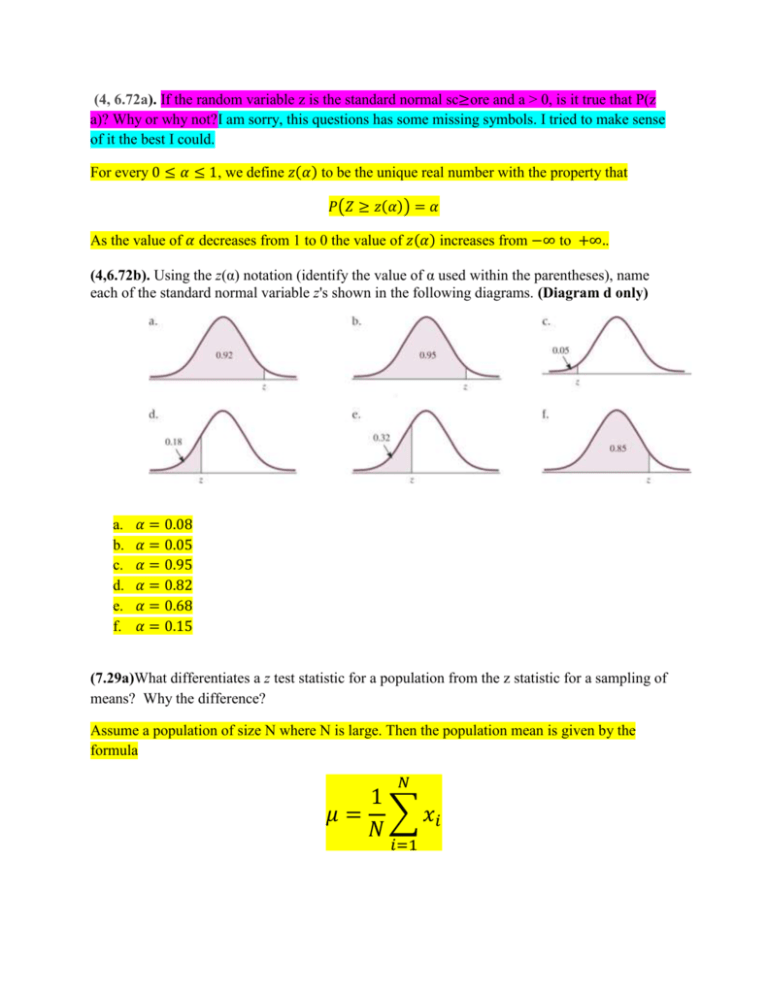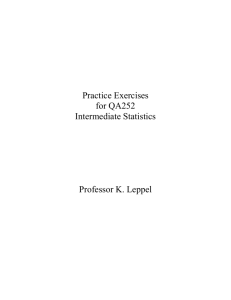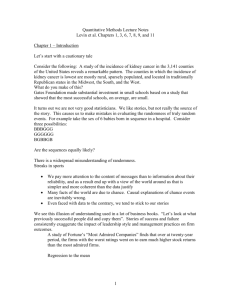(4, 6.72a). If the random variable z is the standard normal score and
advertisement

(4, 6.72a). If the random variable z is the standard normal sc≥ore and a > 0, is it true that P(z a)? Why or why not?I am sorry, this questions has some missing symbols. I tried to make sense of it the best I could. For every 0 ≤ 𝛼 ≤ 1, we define 𝑧(𝛼) to be the unique real number with the property that 𝑃(𝑍 ≥ 𝑧(𝛼)) = 𝛼 As the value of 𝛼 decreases from 1 to 0 the value of 𝑧(𝛼) increases from −∞ to +∞.. (4,6.72b). Using the z(α) notation (identify the value of α used within the parentheses), name each of the standard normal variable z's shown in the following diagrams. (Diagram d only) a. b. c. d. e. f. 𝛼 𝛼 𝛼 𝛼 𝛼 𝛼 = 0.08 = 0.05 = 0.95 = 0.82 = 0.68 = 0.15 (7.29a)What differentiates a z test statistic for a population from the z statistic for a sampling of means? Why the difference? Assume a population of size N where N is large. Then the population mean is given by the formula 𝑁 1 𝜇 = ∑ 𝑥𝑖 𝑁 𝑖=1 Notice that 𝜇 is a (usually unknown) constant. What makes the population mean hard to calculate is the sheer size of N. Even if we do not know the population mean, we want still to get an idea about its magnitude. For this we select a sample of size n out of the entire population. It is much easier to compute the sample mean 𝑛 𝑥̅ = 1 ∑ 𝑥𝑗 𝑛 𝑗=1 Notice that 𝑥̅ is known but it changes from sample to sample. So the sample mean is merely an estimator of the population mean. Conclusion: the population mean is a constant but it’s value is usually not known. On the other hand, the sample mean can be easily computed but it varies from on sample to another. (7.29b)Consider a normal population with μ = 43 and σ = 5.2. Calculate the z-score for an 46.5 from a sample of size 16. z-score = 46.5−43 5.2⁄ √16 = 3.5 1.3 of = 2.69 (8.84a). Give an example of a hypothesis where a Type II Error would be more critical if made than a Type I Error and explain why you feel this way. Suppose that a patient comes to the doctor. The symptoms indicate he is infected with AIDS. Null hypothesis. H0: The patient is healthy Alternative hypothesis. Ha: The patient is infected. A type I error is a false positive: suppose that the patient is healthy and the test rejects the null hypothesis thus wrongly suggesting that the patient is infected. A type II error is a false negative: suppose the patient is infected and the test fails to reject the null hypothesis thus falsely indicating that the patient is healthy. In this scenario a type II error is far more critical than a type I error. In the case of a type I error, the patient will feel compelled to follow up the initial test with more sensitive and accurate tests and in the end he will find out he is actually healthy. However, in the case of a type II error, it is likely the patient will have a sense of false security and blame his symptoms on unrelated causes. Meanwhile the disease progresses and the patient’s condition worsens. (8.84c). State the null hypothesis Ho and the alternative hypothesis Ha that would be used for a hypothesis test related to each of the following statements: c. The mean life of fluorescent light bulbs is at least 1600 hours. 𝐻0 : 𝜇 ≥ 1600 𝐻𝑎 : 𝜇 < 1600











